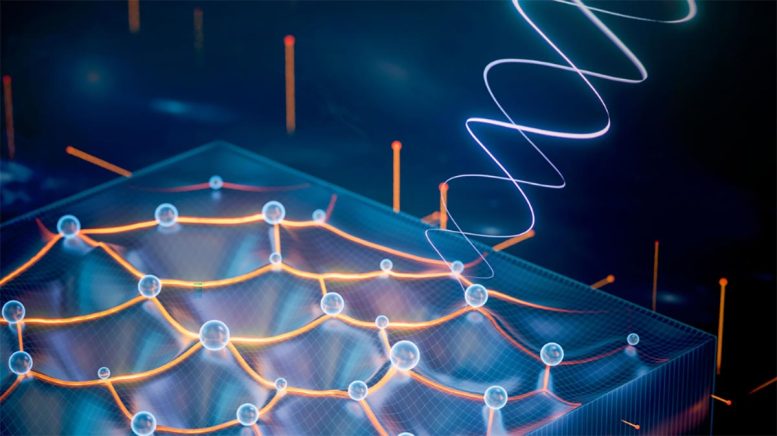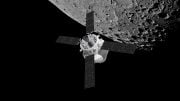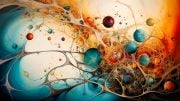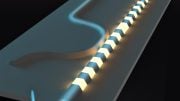
Light probing a chiral graviton mode in a fractional quantum Hall effect liquid. Credit: Lingjie Du, Nanjing University
The results, continuing the legacy of late Columbia professor Aron Pinczuk, are a step toward a better understanding of gravity.
A team of scientists from Columbia, Nanjing University, Princeton, and the University of Munster, writing in the journal Nature, have presented the first experimental evidence of collective excitations with spin called chiral graviton modes (CGMs) in a semiconducting material.
A CGM appears to be similar to a graviton, a yet-to-be-discovered elementary particle better known in high-energy quantum physics for hypothetically giving rise to gravity, one of the fundamental forces in the universe, whose ultimate cause remains mysterious.
Bridging Theoretical Physics and Experimental Reality
The ability to study graviton-like particles in the lab could help fill critical gaps between quantum mechanics and Einstein’s theories of relativity, solving a major dilemma in physics and expanding our understanding of the universe.
“Our experiment marks the first experimental substantiation of this concept of gravitons, posited by pioneering works in quantum gravity since the 1930s, in a condensed matter system,” said Lingjie Du, a former Columbia postdoc and senior author on the paper.
The Quantum Metric and Its Predictions
The team discovered the particle in a type of condensed matter called a fractional quantum Hall effect (FQHE) liquid. FQHE liquids are a system of strongly interacting electrons that occur in two dimensions at high magnetic fields and low temperatures. They can be theoretically described using quantum geometry, emerging mathematical concepts that apply to the minute physical distances at which quantum mechanics influences physical phenomena.
Electrons in an FQHE are subject to what’s known as a quantum metric that had been predicted to give rise to CGMs in response to light. However, in the decade since the quantum metric theory was first proposed for FQHEs, limited experimental techniques existed to test its predictions.
Legacy of Aron Pinczuk: Pioneering Quantum Research
For much of his career, the Columbia physicist Aron Pinczuk studied the mysteries of FQHE liquids and worked to develop experimental tools that could probe such complex quantum systems. Pinczuk, who joined Columbia from Bell Labs in 1998 and was a professor of physics and applied physics, passed away in 2022, but his lab and its alumni across the globe have continued his legacy. Those alumni include article authors Ziyu Liu, who graduated with his PhD in physics from Columbia last year, and former Columbia postdocs Du, now at Nanjing University, and Ursula Wurstbauer, now at the University of Münster.
“Aron pioneered the approach of studying exotic phases of matter, including emergent quantum phases in solid state nanosystems, by the low-lying collective excitation spectra that are their unique fingerprints,” commented Wurstbauer, a co-author on the current work. “I am truly happy that his last genius proposal and research idea was so successful and is now published in Nature. However, it is sad that he cannot celebrate it with us. He always put a strong focus on the people behind the results.”
Innovative Techniques in Quantum Physics
One of the techniques Pinczuk established was called low-temperature resonant inelastic scattering, which measures how light particles, or photons, scatter when they hit a material, thus revealing the material’s underlying properties.
Liu and his co-authors on the Nature paper adapted the technique to use what’s known as circularly polarized light, in which the photons have a particular spin. When the polarized photons interact with a particle like a CGM that also spins, the sign of the photons’ spin will change in response in a more distinctive way than if they were interacting with other types of modes.
International Collaboration and Quantum Geometry
The new paper in Nature was an international collaboration. Using samples prepared by Pinczuk’s long-time collaborators at Princeton, Liu and Columbia physicist Cory Dean completed a series of measurements at Columbia. They then sent the sample for experiments in low-temperature optical equipment that Du spent over three years building in his new lab in China. They observed physical properties consistent with those predicted by quantum geometry for CGMs, including their spin-2 nature, characteristic energy gaps between its ground and excited states, and dependence on so-called filling factors, which relate the number of electrons in the system to its magnetic field.
Theoretical Implications and Future Directions
CGMs share those characteristics with gravitons, a still-undiscovered particle predicted to play a critical role in gravity. Both CGMs and gravitons are the result of quantized metric fluctuations, explained Liu, in which the fabric of spacetime is randomly pulled and stretched in different directions. The theory behind the team’s results can therefore potentially connect two subfields of physics: high energy physics, which operates across the largest scales of the universe, and condensed matter physics, which studies materials and the atomic and electronic interactions that give them their unique properties.
In future work, Liu says the polarized light technique should be straightforward to apply to FQHE liquids at higher energy levels than they explored in the current paper. It should also apply to additional types of quantum systems where quantum geometry predicts unique properties from collective particles, such as superconductors.
“For a long time, there was this mystery about how long wavelength collective modes, like CGMs, could be probed in experiments. We provide experimental evidence that supports quantum geometry predictions,” said Liu. “I think Aron would be very proud to see this extension of his techniques and new understanding of a system he had studied for a long time.”
Reference: “Evidence for chiral graviton modes in fractional quantum Hall liquids” by Jiehui Liang, Ziyu Liu, Zihao Yang, Yuelei Huang, Ursula Wurstbauer, Cory R. Dean, Ken W. West, Loren N. Pfeiffer, Lingjie Du and Aron Pinczuk, 27 March 2024, Nature.
DOI: 10.1038/s41586-024-07201-w







The interaction and balance of topological vortices not only demonstrate the beauty of mathematics, but also change the way humanity understand nature. Studying topological vortices can greatly expand the boundaries of humanity cognition.
The results, continuing the legacy of late Columbia professor Aron Pinczuk, are a step toward a better understanding of gravity. Please think deeply,
1. Can topological vortices generate gravitation?
2. Can mathematics explain physical phenomena?
3. Is topological vortices a physical reality?
4. Where does the gravitational force of the researcher’s Graviton-like Particles come from?
Science must eliminate falsehood and preserve truth. The things that researchers can observe in experiments are always superficial phenomena, not essential.
According to topological vortex gravitational field theory, spin creates everything, spin creates the world, spin creates the future. In the interaction of topological vortices, time is both absolute and relative,and physics often requires treating space and time at the same level. Spin generates time, spin generates gravitation, spin generates energy, spin generates evolution. Each topological vortex is a quantum clock. Starting from the formation of topological vortices, precise timing begins.
The interaction and balance of topological vortices not only demonstrate the beauty of mathematics, but also change the way humanity understand nature. Studying topological vortices can greatly expand the boundaries of humanity cognition.
All observable movements in the physical world are inseparable from the interaction of topological vortices, including human observational behavior itself.
The universe does not do algebra, formula or fraction. The universe is geometrythe, and is the superposition, deflection, and twisting of geometric shapes.
Today, we have already entered the era of the internet. With the help of artificial intelligence and big data, discussions on scientific knowledge have become open and transparent. However, a group of editors of so-called academic journals (such as Physical Review Letters, Nature, Science, etc.) are self righteous, self proclaimed, fooling the public, lack remorse, and mystifying themselves. They only care about their own so-called sufficiently high priority rating, general significance, discipline, novelty, etc., and do not care about what science and pseudoscience are.
Science and pseudoscience are not determined by a publication, an organization or a person, nor by you or me, but by mathematics the final say. Physical models must be based on mathematics or mathematical models in order to be scientific, convincing, and in accordance with natural laws.
The origin of geometry lies in the concerns of everyday life. The branch of geometry (mathematics) known as topology has become a cornerstone of modern physics. Topological vortex and antivortex are two bidirectional coupled continuous chaotic systems. They exhibit parity conservation, charge conjugation, and time reversal symmetry. The synchronization effect is extremely important in their interactions. The synchronization effect of the superposition, deflection, and twisting of multiple or countless topological vortices will make spacetime motion more complex. To understand this complex world, physics should respect the authenticity of topological vortex in low dimensional spacetime, rather than simply relying on a few formulas, numbers, or imagined particles.
Spin is a natural property of topological vortices. Spin is synchronized with energy, spin is synchronized with gravitation, spin is synchronized with time, spin is synchronized with evolution. The perpetually swirling topological vortices defy traditional physics’ expectations. One physical properties of topological vortices is them to spontaneously begin to change periodically in time, even though the system does not experience corresponding periodic interference. Therefore, in the interaction of topological vortices, time is both absolute and relative,and physics often requires treating space and time at the same level.
Low-dimensional spacetime matter is the foundation of high-dimensional spacetime matter. Low-dimensional spacetime matter (such as topological vortex) can form new material structures and derive more complex physical properties via interactions and self-organization. It is extremely wrong and irresponsible to imagine low dimensional spacetime matter using high-dimensional spacetime matter,such as a cat in quantum mechanics.
Science must follow mathematical rules. For example, the Standard Model (SM) is considered to be one of the most significant achievements of physics in the 20th century. However, the magnetic moment of μ particle is larger than expected, revealed by a g-2 experiment at Fermilab, suggests that the established theory (such as SM) of fundamental particles is incomplete. Furthermore, the SM omitting gravitation, it not involved the time problem and when the particle movement starts. Mathematics is the foundation of science. Physics must respect the scientific nature of mathematics and mathematical models. The SM must be based on mathematical models in order to be scientific, convincing, and in line with natural laws.
I hope researchers are not fooled by the pseudoscientific theories of the Physical Review Letters (PRL), and hope more people dare to stand up and fight against rampant pseudoscience.
The so-called academic journals (such as Physical Review Letters, Nature, Science, etc.) firmly believe that two high-dimensional spacetime objects (such as two sets of cobalt-60) rotating in opposite directions can be transformed into two objects that mirror each other, is a typical case of pseudoscience rampant.
If researchers are really interested in Science and Physics, you can browse https://zhuanlan.zhihu.com/p/643404671 and https://zhuanlan.zhihu.com/p/595280873.
The Physical Review Letters (PRL) is the most evil, ugly, and dirty publication in the history of science. Nature and Science have been influenced by Physical Review Letters (PRL) and are even more notorious. The behavior of these pseudo-academic publications has seriously hindered the progress and development of human society in science and technology.
I am well aware that my relentless repetition can make some people unhappy, but in the fight against rampant pseudoscience, that’s all I can do.